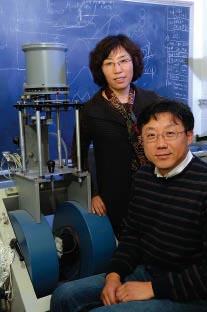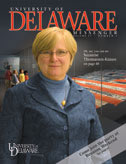Tiny particles may be linked to food chain

RESEARCH | Manmade nanoparticles—bits of chemicals a thousand times smaller than a human cell—increasingly are being used in a host of products, but the human and environmental health risks associated with these tiny engineered particles are not well known.
Now, researchers at UD have provided what is believed to be the first experimental evidence that plants can take up these nanoparticles and accumulate them in their tissues. The laboratory study, which involved pumpkin plants, indicates a possible pathway for nanoparticles to enter the food chain. It also reveals a new experimental approach for studying nanoparticles and their potential impacts.
Yan Jin, professor of soil physics in the College of Agriculture and Natural Resources, and John Xiao, professor of physics and astronomy in the College of Arts and Sciences, led the study, working with colleagues Jung-youn Lee and Harsh Bais at the Delaware Biotechnology Institute, a premier research center at the University.
The results were published in a cover article in the Journal of Environmental Monitoring and also were highlighted in Chemical Biology, a journal of the Royal Society of Chemistry.
While nanoparticles occur naturally in the environment, they also are being manufactured for use in everything from electronics to cosmetics, fuel cells to medical procedures. Because chemical compounds can take on different properties at such a reduced size, there is concern that these invisible particles could easily be breathed in by humans and animals, with damaging or toxic effects.
“Plants serve as a foundation of the food chain,” Jin says. “We demonstrated this possible route for nanoparticles in the environment; whether it poses potential harm to human health depends on many factors. This is a preliminary study, which we hope will spur additional interdisciplinary research by the scientific community.”
The researchers chose pumpkins for the study, Jin says, because they take in a lot of water and are easy to grow.
The plants were grown hydroponically in an aqueous mediumto which nanoparticles of iron oxide, or magnetite, a magnetic form of iron ore, were added. After 20 days of growth, the plants were cut into pieces and dried in a vacuum dessicator. A magnetometer was then used to detect if any of the particles had been absorbed by the plant.
“Our study was a worst-case scenario in order to test the feasibility of our approach in being able to detect the particle,” Xiao says. “It really provides a new technique for doing this kind of research.”
The researchers say that in their initial screening tests, no magnetic signals were detected in lima bean plants, compared with the strong signals in pumpkin plants, which suggests that different plants have varied responses to nanosized particles.
Jin notes how important interdisciplinary collaboration has been to the research and says she hopes to see plant scientists and molecular biologists involved in future studies to see how nanoparticles actually get into plants. “Some believe it is a passive process; others are convinced it is an active one,” she says.
The project was funded by the Delaware Experimental Program to Stimulate Competitive Research, which is supported by the National Science Foundation and the state of Delaware. Jin and Xiao also recently won a grant from the Environmental Protection Agency to examine the fate and transport of engineered nanoparticles in porous media, including soil and groundwater.
For more on research at the University of Delaware, visit www.udel.edu/research.
Article by Diane S. Kukich, AS ’73, ’84M





